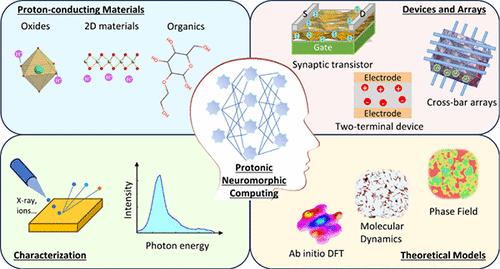当前位置:
X-MOL 学术
›
Chem. Rev.
›
论文详情
Our official English website, www.x-mol.net, welcomes your feedback! (Note: you will need to create a separate account there.)
Proton Conducting Neuromorphic Materials and Devices
Chemical Reviews ( IF 51.4 ) Pub Date : 2024-07-22 , DOI: 10.1021/acs.chemrev.4c00071 Yifan Yuan 1 , Ranjan Kumar Patel 1 , Suvo Banik 2, 3 , Tadesse Billo Reta 4 , Ravindra Singh Bisht 1 , Dillon D. Fong 4 , Subramanian K. R. S. Sankaranarayanan 2, 3 , Shriram Ramanathan 1
Chemical Reviews ( IF 51.4 ) Pub Date : 2024-07-22 , DOI: 10.1021/acs.chemrev.4c00071 Yifan Yuan 1 , Ranjan Kumar Patel 1 , Suvo Banik 2, 3 , Tadesse Billo Reta 4 , Ravindra Singh Bisht 1 , Dillon D. Fong 4 , Subramanian K. R. S. Sankaranarayanan 2, 3 , Shriram Ramanathan 1
Affiliation

|
Neuromorphic computing and artificial intelligence hardware generally aims to emulate features found in biological neural circuit components and to enable the development of energy-efficient machines. In the biological brain, ionic currents and temporal concentration gradients control information flow and storage. It is therefore of interest to examine materials and devices for neuromorphic computing wherein ionic and electronic currents can propagate. Protons being mobile under an external electric field offers a compelling avenue for facilitating biological functionalities in artificial synapses and neurons. In this review, we first highlight the interesting biological analog of protons as neurotransmitters in various animals. We then discuss the experimental approaches and mechanisms of proton doping in various classes of inorganic and organic proton-conducting materials for the advancement of neuromorphic architectures. Since hydrogen is among the lightest of elements, characterization in a solid matrix requires advanced techniques. We review powerful synchrotron-based spectroscopic techniques for characterizing hydrogen doping in various materials as well as complementary scattering techniques to detect hydrogen. First-principles calculations are then discussed as they help provide an understanding of proton migration and electronic structure modification. Outstanding scientific challenges to further our understanding of proton doping and its use in emerging neuromorphic electronics are pointed out.
中文翻译:

质子传导神经形态材料和设备
神经形态计算和人工智能硬件通常旨在模拟生物神经电路组件中的功能,并实现节能机器的开发。在生物大脑中,离子电流和时间浓度梯度控制信息流动和存储。因此,研究用于神经形态计算的材料和设备是很有意义的,其中离子和电子电流可以传播。质子在外部电场下的移动为促进人工突触和神经元的生物功能提供了一条引人注目的途径。在这篇综述中,我们首先强调质子作为各种动物神经递质的有趣的生物类似物。然后,我们讨论了在各类无机和有机质子传导材料中进行质子掺杂的实验方法和机制,以促进神经形态结构的进步。由于氢是最轻的元素之一,因此固体基质的表征需要先进的技术。我们回顾了用于表征各种材料中氢掺杂的强大的基于同步加速器的光谱技术以及用于检测氢的互补散射技术。然后讨论第一原理计算,因为它们有助于理解质子迁移和电子结构修改。指出了进一步了解质子掺杂及其在新兴神经形态电子学中的应用所面临的突出科学挑战。
更新日期:2024-07-23
中文翻译:

质子传导神经形态材料和设备
神经形态计算和人工智能硬件通常旨在模拟生物神经电路组件中的功能,并实现节能机器的开发。在生物大脑中,离子电流和时间浓度梯度控制信息流动和存储。因此,研究用于神经形态计算的材料和设备是很有意义的,其中离子和电子电流可以传播。质子在外部电场下的移动为促进人工突触和神经元的生物功能提供了一条引人注目的途径。在这篇综述中,我们首先强调质子作为各种动物神经递质的有趣的生物类似物。然后,我们讨论了在各类无机和有机质子传导材料中进行质子掺杂的实验方法和机制,以促进神经形态结构的进步。由于氢是最轻的元素之一,因此固体基质的表征需要先进的技术。我们回顾了用于表征各种材料中氢掺杂的强大的基于同步加速器的光谱技术以及用于检测氢的互补散射技术。然后讨论第一原理计算,因为它们有助于理解质子迁移和电子结构修改。指出了进一步了解质子掺杂及其在新兴神经形态电子学中的应用所面临的突出科学挑战。












































 京公网安备 11010802027423号
京公网安备 11010802027423号